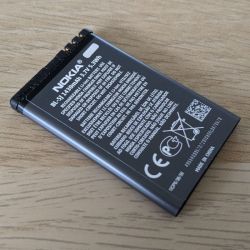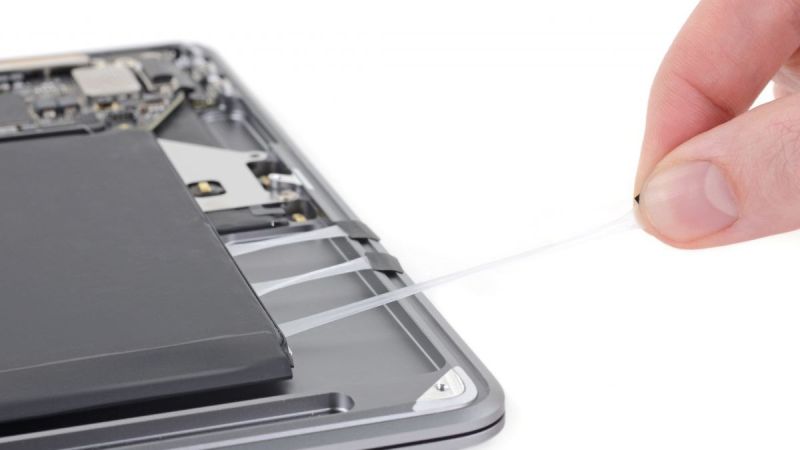Anyone who enjoys opening up consumer electronics knows iFixit to be a valuable resource, full of reference pictures and repair procedures to help revive devices and keep them out of electronic waste. Champions of reparability, they’ve been watching in dismay as the quest for thinner and lighter devices also made them harder to fix. But they wanted to cheer a bright spot in this bleak landscape: increasing use of stretch-release adhesives.

Once upon a time batteries were designed to be user-replaceable. But that required access mechanisms, electrical connectors, and protective shells around fragile battery cells. Eliminating such overhead allowed slimmer devices, but didn’t change the fact that the battery is still likely to need replacement. We thus entered into a dark age where battery pouches were glued into devices and replacement meant fighting clingy blobs and cleaning sticky residue. Something the teardown experts at iFixit are all too familiar with.
This is why they are happy to see pull tabs whenever they peer inside something, for those tabs signify the device was blessed with stretch-release adhesives. All we have to do is apply a firm and steady pull on those tabs to release their hold leaving no residue behind. We get an overview of how this magic works, with the caveat that implementation details are well into the land of patents and trade secrets.
But we do get tips on how to best remove them, and how to reapply new strips, which are important to iFixit’s mission. There’s also a detour into their impact on interior design of the device: the tabs have to be accessible, and they need room to stretch. This isn’t just a concern for design engineers, they also apply to stretch release adhesives sold to consumers. Advertising push by 3M Command and competitors have already begun, reminding people that stretch-release adhesive strips are ideal for temporary holiday decorations. They would also work well to hold batteries in our own projects, even if we aren’t their advertised targets.
Our end-of-year gift-giving traditions will mean a new wave of gadgets. And while not all of them will be easily repairable, we’re happy that this tiny bit of reparability exists. Every bit helps to stem the flow of electronics waste.
















Well.. It didn’t start out so well with the stretch release adhesive. In the iPhone 5S and 5C where I first saw this black magic, it would stretch… and then break. No matter how careful I was. Leaving no way to remove the battery without prying and bending, and risking the thing puncturing and catching fire.
Things improved a lot after that, but I’m not sure I’ll ever trust it completely.
Yeah same? I ended up warming the device well and then pulling on one end of the cell quite firmly, I noticed the adhesive was slowly giving way. Over time I was able to extract the battery. Let’s just say the battery had quite a bend in it by the time it was all done and dusted. I don’t see it as such a good system…. maybe it was too cold and thus too stiff, I’ll never know. Has anybody managed to quantify what is needed to have the adhesive release as planned?
Recently changed the battery in an iPhone X and it worked pretty well but I did it by pulling the adhesive taut and then wrapping it around a pair of tweezers before pulling again and repeating so I wasn’t really stretching the same section over and over again
This^
The trick is to make sure the adhesive stays in one piece. I like the “curl it around the tweezers”-technique too, but it’s also important that it doesn’t get caught on anything while pulling it out. It easily gets damaged by vibrators or the battery itself if you pull it out at an angle. It’s a good idea to remove components in the way of pulling it straight out.
I’ve had the most success doing it this way.
I think they should rotate the adhesive strip 90 degrees, that way the tape is much shorter.
LMAO first time I ever worked with this was in my iPhone 5c… I broke that adhesive strip faster than you can say “battery”.
My favorite stretch-release use so far: In a rental apartment, putting up a shower curtain rod with the cups normally used for closet rods.
3M command is AMAZING! I hate using disposable stuff for event decorations, but it works fabulously.
“with the caveat that implementation details are well into the land of patents and trade secrets.”
Fortunately patents are open source and expire so you can make your own now.
Filed by 3M in 1999 (expired now) – Stretch releasing adhesive tape with integral pull tab – https://patents.google.com/patent/US6541089B1/en
Gleaning over that patent it looks like it does a great job of describing what characteristics stretch release adhesives have, but not so much info that translates into how you could make it as is usually the case with patents.
So I guess you can make your own, as long as you have someone well versed in material science willing to go through the patent and do a little R&D project for to pick the materials that fit the bill.
Hmm glad all of my phones so far have actually been designed to have the battery replaced. They just notched and locked into place. No tape or glue or tape/glue needed. Not sure why designers have such a hard time putting two plastic nubs inside of something. Seems way more trustworthy than 20 flexcable interconnects between boards and components (cough apple cough).
the same company that doesn’t see it as a problem to put a pin with 50+volts right next to a pin with an eDP data line that goes directly into a CPU in the display connector? Come on now, we both know they are the masters of failed engineering solutions…
Thanks for the Obi-Wan reference :)
I encountered it in a xiaomi redmi 4x. It broke and i started to hate it. I will not use it.